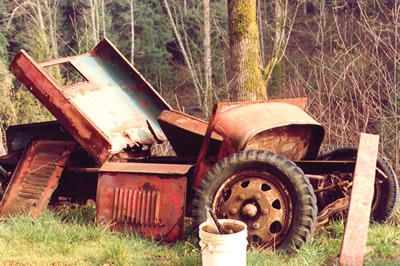
COVER FEATURE - DECEMBER 2002

Jerry & Gayle Jeffries’
1929 Fageol has the uncanny ability to excite just about everyone who sees it.
This custom hot rod truck appeals to those who like loud, fast street rods;
to the “old timers” who appreciate the historical impact the Fageol had on big
rig trucks; to younger truckers because it’s a neat old rig; and even to the
general public because it is a flashy, unique and interesting vehicle. Jerry
& Gayle (who are two of the nicest folks you’ll ever meet) built the Fageol
to help promote their truck accessory company (Double JJ Enterprises) and to
have some fun - both of which they have accomplished.
Today, this truck is a beautiful piece of craftsmanship thanks to the efforts
of Jerry and the people who helped him. But the old truck wasn’t always this
pretty. This “truck” was found sitting in the weeds under an old apple tree
in Woodinville, WA. It is amazing to think that the pile of parts found under
that tree nine years ago is now the awesome vehicle on our cover this month.
Some of you might not be familiar with the historical significance of Fageol
trucks, so let’s take a brief look back at the story of Fageol.

Fageol was founded in 1916 by
two brothers, Frank and William Fageol. Their trucks had a reputation for high
quality (and price), sturdy construction, and great pulling power. They began
producing a few vehicles in 1916 and constructed their factory in Oakland, CA
in 1917, where they built cars, trucks and orchard tractors. Fageol trucks were
easily identified by their patented feature - a row of sawtooth louvers that
ran down the center of the hood. These louvers were good for airflow, but were
probably more for looks than anything else. In 1921 Fageol expanded their product
line to include buses. The success of this product led to the purchase of a
factory in Ohio dedicated solely to bus production.
The 1930s saw the continued growth of long-haul trucking. Though sales were
down, trucking was not as devastated by the Depression as many other businesses.
New models and designs were continually introduced. Still, many companies fell
into bankruptcy. One of these was the Fageol Truck & Coach Company.

The Waukesha Motor Company and
the Central Bank of Oakland operated Fageol from 1932 until 1938. That year,
they sold Fageol’s truck operations to T.A. Peterman, a logger and plywood manufacturer
from Tacoma, WA. Peterman had been rebuilding surplus army trucks and modifying
old logging trucks for use in his business. By 1938, his lumber operations had
expanded beyond the capabilities of his fleet, so he purchased the Fageol truck
assets in order to build chain-driven logging trucks. 1938 was the last year
of production for the Fageol. Peterman reorganized the company, changed the
name to Peterbilt, and continued the tradition to this day of building trucks
known for their strength, stamina and reliability.
As you can see, the Fageol was basically an early Peterbilt. Or, some might
say, the Peterbilt was a modern-day Fageol. However you look at it, these trucks
left their mark in the trucking history books. This brings us back to Jerry’s
unique 1929. You won’t find any other Fageols that look (or run) like Jerry’s.
Jerry & Gayle were fortunate enough to recently meet a grandson of the Fageol
family. He admired the truck and said that it was the best lookin’ Fageol he’d
ever seen.
Jerry’s truck was originally a 5-ton farm truck. After a life of use, it was
parked under an apple tree and left to decompose. That is, until Jerry’s friend
John Hartman of Castaic, CA found it. John had the truck for many years and
began the restoration, but over time got side-tracked and stopped working on
the truck. Jerry always admired the Fageol, and told John if he ever wanted
to sell it, to call him first. In April of 2001, Jerry got the call and jumped
at the chance to buy the truck.
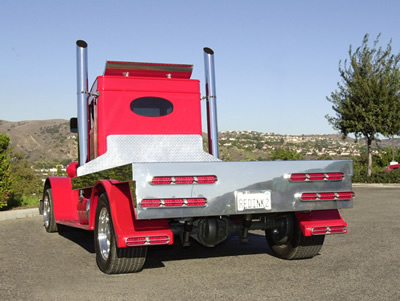
At the time of its purchase,
the truck was painted with primer and had the present motor in it but it wasn’t
functional. The doors were hung and the fenders were installed, but the truck
had no glass. It is important to note that this truck was not “pieced together”
with parts found here and there. All of the truck’s main parts including the
frame rails, grille, top of hood, cab, cowl, fenders (front) and running boards
(front portion) are original. The headlights are original too, but Jerry inserted
sealed-beam lights into cutouts he made in the back of the original lights for
brighter illumination. Most of these original pieces have been modified, but
the truck still retains its “period” look. Jerry wanted to “hot rod” the truck
but not lose its classic design.
After purchasing the truck, he sent it to a friend in Fresno, CA named Bob Amos.
Jerry attributes most of the work, fabrication and paint to Bob. He began by
stripping the truck down to the bare metal and refinishing everything. The hood
was not salvageable, so a new one had to be built. A tilt hood was fabricated
with the original sawtooth louvers integrated into the design. Other major fabrication
included chopping five inches off the top of the cab and completely changing
the interior. Conners Manufacturing in Fresno, CA built a custom aluminum bed
with a hardwood floor. Ron Watt of WTI in Indiana fabricated the rear portion
of the running boards and the rear fenders. He also lowered the truck’s floorboard
a few inches to make the truck more comfortable to drive. Ron also installed
a stainless steel firewall and chromed many of the engine components. Everything
is fabricated from 1/8” steel - no fiberglass here! The truck, weighing in at
5,100 pounds, required Jerry to beef up the suspension.
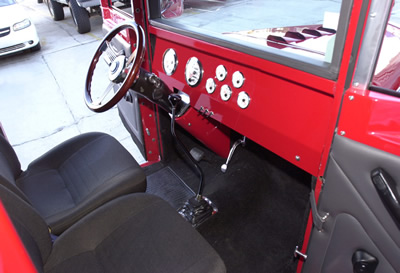
As old as it is, this truck
is pretty modern under the hood and inside the cab. Powered by a Chrysler 440
which pumps about 300 hp to the custom 8-lug Centerline wheels with low profile
rubber through a 727 TorqueFlite automatic transmission, this old truck has
plenty of get-up-and-go. It also has power steering, power brakes and a tilt
steering column. The door handles were shaved and a keyless entry system was
added. The doors pop open with the push of a button on a small remote attached
to Jerry’s key ring. The doors, which are not original, were acquired from a
Freightliner cab-over. These modern doors enabled Jerry to add not only the
keyless entry system but also power windows. The truck features a “2-70” air
conditioning system (2 windows rolled down at 70 mph), a pair of Bostrom air
seats, a solid wood steering wheel, a custom flat steel dash fitted with Double
JJ’s own Classic Signature gauges and custom door panels with the Fageol logo
stitched into them, made by Cal-Fast in Fresno, CA.
Final exterior touches included dual five-inch stacks, a stainless wing and
six bus lights atop the cab, Double JJ blinker bars and light grilles, side
mirrors from a 1940s-era pickup truck, an old-style motor meter/hood ornament
made by Double JJ and, of course, a flashy paint job featuring Jerry’s signature
color (Viper Red). Just for fun, Jerry had a small steel hammer attached to
the throttle linkage and a little polished steel anvil bolted to the intake
manifold, so that when he “puts the hammer down” he is doing it both literally
and figuratively.
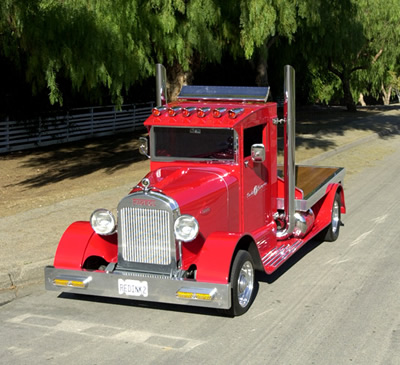
The license plate reads “Red Ink 2” and offers an answer to the frequently asked
question, “How much did you spend on this?” The original “Red Ink” was a show
Pete Jerry built a few years ago to promote Double JJ products. Jerry also has
an original (not a copy) registration card for the Fageol dated 12-26-33. As
stated on the card, the truck’s registration fee that year was $33.00 (a lot
of money back then). Also noted on the card is the original sale date of the
vehicle (1-31-30).
With a background in engineering, business and trucking, Jerry designed and
built the first set of “J-Lights” (the popular drop-down, round headlight brackets
seen on many Petes today) in 1994. At that time, Double JJ Enterprises was the
name of Jerry & Gayle’s trucking company, but as the light brackets became
more popular, they slowly phased out their trucking operations. Since Peterbilt’s
blinkers were incorporated into the OEM headlight assembly, Jerry had to design
a blinker bar to correct the problem his brackets created. Eventually, this
product line became as popular as the light brackets. Easy installation was
a real selling point for both the headlight brackets and blinker bars (both
pieces fit directly into existing holes).
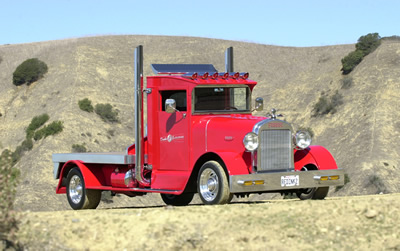
Currently, Double JJ Enterprises, located in Anaheim, CA produces and sells
several truck accessory products through a network of over 400 dealers throughout
the U.S. and Canada. Their product line includes headlight brackets for Peterbilts
and KWs, four different kinds of light grilles, old-style motor meters and radiator
caps, hood ornaments, and their latest headlight system that fits seven different
kinds of trucks. All of their products are of the highest quality. Jerry &
Gayle truly appreciate their customers and are quite aware of the fact that
without their business, they would have no business.
Spending an entire day with Jerry & Gayle and the Fageol showed us just
how much people out there really like this truck. We (actually the truck) got
a lot of attention that day. And when you can promote your company and have
a good time, well, that’s just double the fun. We’d like to thank Jerry &
Gayle for letting us get their old truck a little dirty, trudging around the
muddy hills of Southern California.
